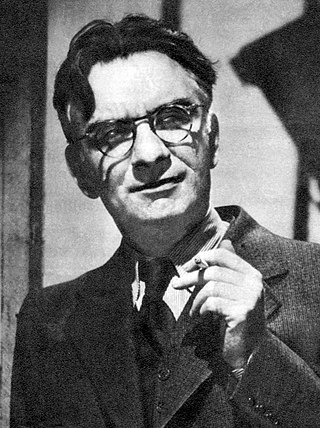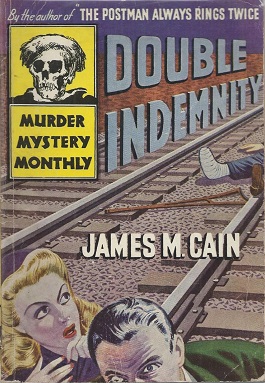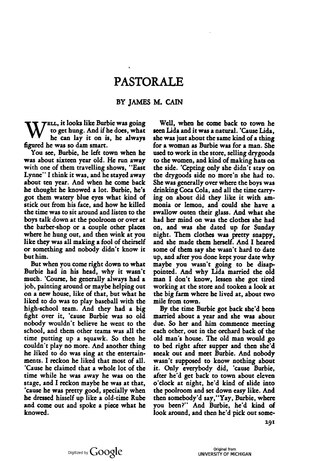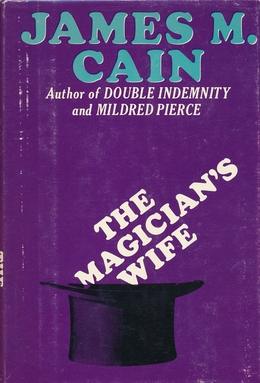Mildred Pierce is a psychological drama by James M. Cain published by Alfred A. Knopf in 1941.

James Mallahan Cain was an American novelist, journalist and screenwriter. He is widely regarded as a progenitor of the hardboiled school of American crime fiction.

The Postman Always Rings Twice is a 1934 crime novel by American writer James M. Cain. The novel was successful and notorious upon publication. It is considered one of the most outstanding crime novels of the 20th century. The novel's mix of sexuality and violence was startling in its time and caused it to be banned in Boston.

Double Indemnity is a 1943 crime novel by American journalist-turned-novelist James M. Cain. It was first published in serial form in Liberty magazine in 1936 and later republished as one of "three long short tales" in the collection Three of a Kind.

“Pastorale” is a short story written by James M. Cain and published in March, 1928 by editor H. L. Mencken in The American Mercury. Written in the Ring Lardner style, the tale is told in a first-person narrative, delivered in the dialect of a resident of rural America. Both the point-of-view and the use of colloquial dialect for his protagonists, fully established in “Pastorale”, would be applied in many of Cain’s novels.
Career in C Major is an opera-themed novella by American writer James M. Cain, first published in 1938. First appearing as a serial in The American Magazine entitled "Two Can Sing", this comic romance is a departure from Cain's first novels, Postman Always Rings Twice (1934) and Double Indemnity (1936), both hardboiled crime stories that included premeditated murder. Redbook magazine, disappointed that Cain had exchanged his hard-boiled themes involving sex and murder for a "comedic adventure", declined to purchase the novella but Liberty obtained the piece and carried it as a serial in 1935.

Three of a Kind is a collection of three novellas by James M. Cain, published by Alfred A. Knopf in 1943. Each originally appeared as serials in magazines during the 1930s. The collection includes Double Indemnity, first published in 1936 as a serial for Liberty magazine; Career in C Major, originally entitled "Two Can Sing" when it appeared in The American Magazine in 1938; and The Embezzler, appearing in Liberty as "Money and the Woman", also in 1938.

Serenade is a novel by James M. Cain published in 1938 by Alfred A. Knopf. and one of four Cain novels to feature opera as a plot device. Loosely based on Bizet's Carmen, the story explores the sources of artistic development, in particular the role played by sexual orientation in the development of artistic talent.

Love's Lovely Counterfeit is a hard-boiled short novel by James M. Cain published by Alfred A. Knopf in 1942. The story is set in a Midwestern town where rival gangsters struggle to maintain control of their criminal enterprises. The work is one of only three of Cain's novels told from the third-person point-of-view.

The Butterfly is a hard-boiled novel by author James M. Cain published by Alfred A. Knopf in 1947. The story is set in rural West Virginia in the late 1930s and concerns a mystery surrounding an apparent case of father and daughter incest.

Our Government is a collection of satirical dialogues and sketches by James M. Cain published in 1930 by Alfred A. Knopf as part of The American Scene series. Our Government is the first of Cain's many books.
The Taking of Montfaucon is a short story by James M. Cain first published in H. L. Mencken’s The American Mercury in 1929.
7-11 is a play by James M. Cain staged in August 1937 on Cape Cod produced by Richard Aldrich and directed by Alexander Dean.

Sinful Woman is a detective novel by James M. Cain that appeared originally as a paperback in 1947 by Avon publishers. Sinful Woman was the most commercially successful of three paperbacks Cain wrote for Avon in the late 1940s and early 1950s.

Galatea is a romance novel by James M. Cain published by Alfred A. Knopf in 1953. The story alludes to the mythological Galatea in which the sculptor Pygmalion falls in love with the ivory figure of a woman he has crafted. In Cain’s modernized version of the Greek legend, an overweight woman is transfigured through a program of weight reduction into a goddess-like beauty.

The Root of His Evil is a novel by James M. Cain published in paperback by Avon in 1951.

The Moth is a novel by James M. Cain published in 1948 by Alfred A. Knopf. The work is the last of Cain’s four novels to feature opera as a central element of the story; the others are Serenade (1937), Mildred Pierce (1941) and Career in C Major (1943) At over three-hundred pages, The Moth is Cain’s “most personal, most ambitious and longest book” in his oeuvre, attempting to convey a “broad, social landscape” of America in the 1930s.

Mignon is a historical novel by James M. Cain published by the Dial Press in 1962. Along with Past All Dishonor (1946), Mignon is one of Cain’s two historical novels set during the American Civil War.

The Magician's Wife is a novel by James M. Cain published in 1965 by Dial Press.

Jealous Woman is a mystery novel by James M. Cain published in 1950 by Avon.